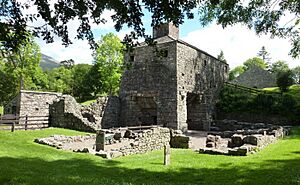Bonawe Iron Furnace facts for kids
The Bonawe Iron Furnace was a big factory in Bonawe, Scotland. It was also known as the Lorn Furnace. This factory made pig iron in the 1700s. Pig iron is a basic type of iron. The main part of the factory was a special oven called a blast furnace. It used charcoal as fuel.
Contents
History of the Iron Furnace
The Newland Company built the Bonawe Iron Furnace in 1753. This company was from Cumbria, England. They chose this spot because there was lots of wood nearby. Wood was needed to make charcoal for the furnace. There was also a strong river to power a water wheel. This wheel helped the furnace work.
It took about one week to heat up the furnace. Once hot, it ran almost non-stop for nine months. The factory employed around 600 people when it was busiest. Most workers collected wood and made charcoal. Each day, the furnace could make about 2,500 kilograms of pig iron. This added up to 700,000 kilograms each year.
The Bonawe factory did not make finished iron products. It only made pig iron bars and simple items like cannonballs. Most of the pig iron went to Cumbria for more processing.
Around 1750, factories started using coke instead of charcoal. Coke was a cheaper fuel for iron making. The first Scottish furnace to use coke opened in 1759. This new way of making iron made Bonawe less profitable. Production dropped a lot in the 1800s. The Bonawe Iron Furnace finally closed in 1876. Today, Historic Scotland looks after the furnace remains.
How the Furnace Was Built
The Bonawe Iron Furnace complex had four main buildings. Two buildings stored charcoal. One building stored iron ore. The fourth building held the actual smelting furnace. There were also other buildings. These included homes for workers and a house for the company's manager. An aqueduct brought water to the site. A pier was also built to bring in materials and ship out iron.
Storing Charcoal
There were two large buildings for storing charcoal. They also stored other products, like tree bark. The bark was sold to places that made leather. These storage buildings were built into a hillside. This made it easy to load materials from the top. Workers could then take materials out from the lower front. Together, these buildings could hold over 2,500 cubic meters of charcoal.
Storing Iron Ore
This building was also built on a slope. This helped with loading and unloading materials. Inside, they stored iron ore, like hematite. They also kept other minerals, such as limestone. All these minerals were needed to make pig iron.
The Blast Furnace
The blast furnace was the most important part of the factory. Raw materials were put into the oven from the "charging house." This was on the south side of the building. North of the furnace was the "blowing house." It had large bellows that blew air into the furnace.
A water wheel on the east side powered these bellows. Water for the wheel came from the River Awe. It flowed through an aqueduct to reach the wheel. On the west side was the "casting house." Here, the hot, melted iron was poured into molds. This formed the pig iron bars. Any waste material, called slag, was taken outside.
Gallery






